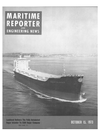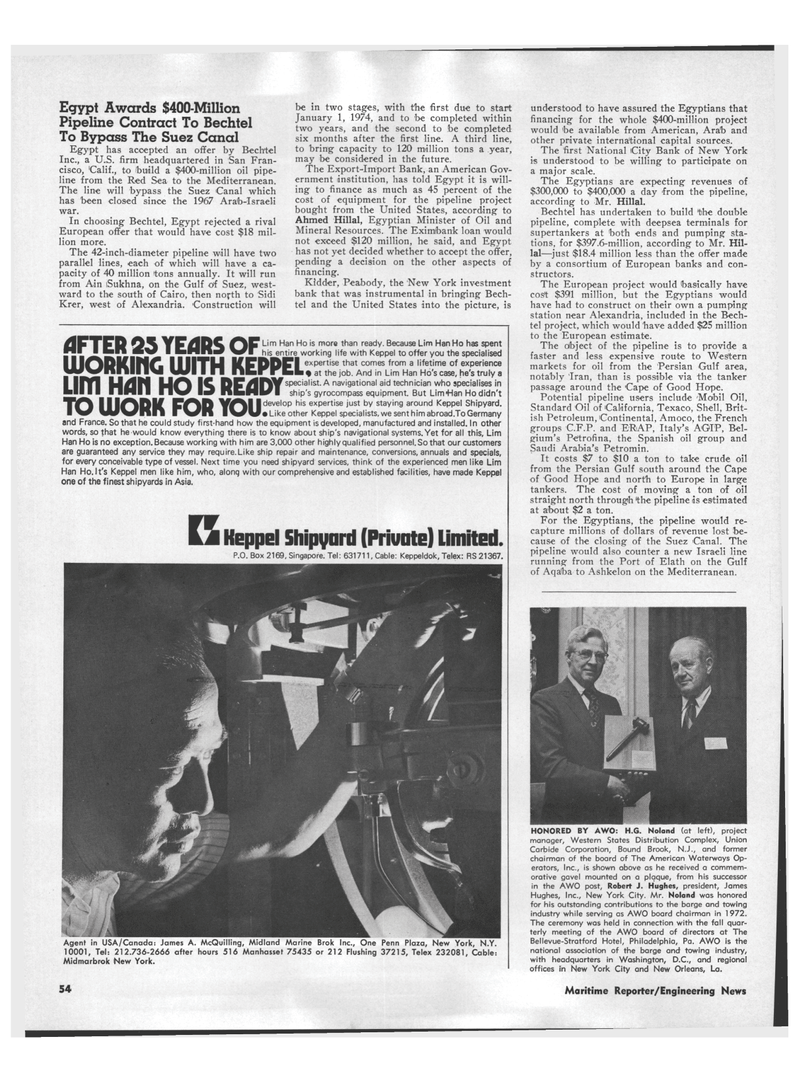
Page 44: of Maritime Reporter Magazine (October 15, 1973)
Read this page in Pdf, Flash or Html5 edition of October 15, 1973 Maritime Reporter Magazine
Egypt Awards $400-Million
Pipeline Contract To Bechtel
To Bypass The Suez Canal
Egypt has accepted an offer by Bechtel
Inc., a U.S. firm headquartered in San Fran- cisco, 'Calif., to build a $400-million oil pipe- line from the Red Sea to the Mediterranean.
The line will bypass the Suez Canal which has been closed since the 1967 Arab-Israeli war.
In choosing Bechtel, Egypt rejected a rival
European offer that would have cost $18 mil- lion more.
The 42-inch-diameter pipeline will have two parallel lines, each of which will have a ca- pacity of 40 million tons annually. It will run from Ain iSukhna, on the Gulf of Suez, west- ward to the south of Cairo, then noj-th to Sidi
Krer, west of Alexandria. Construction will be in two stages, with the first due to start
January 1, 1974, and to be completed within two years, and the second to be completed six months after the first line. A third line, to bring capacity to 120 million tons a year, may be considered in the future.
The Export-Import Bank, an American Gov- ernment institution, has told Egypt it is will- ing to finance as much as 45 percent of the cost of equipment for the pipeline project bought from the United States, according to
Ahmed Hillal, Egyptian Minister of Oil and
Mineral Resources. The Eximibank loan would not exceed $120 million, he said, and Egypt has not yet decided whether to accept the offer, pending a decision on the other aspects of financing.
Kidder, Peabody, the New York investment bank that was instrumental in bringing Bech- tel and the United States into the picture, is
Agent in USA/Canada: James A. McQuilling, Midland Marine Brok Inc., One Penn Plaza, New York, N.Y. 10001, Tel: 212.736-2666 after hours 516 Manhasset 75435 or 212 Flushing 37215, Telex 232081, Cable:
Midmarbrok New York.
ACTpD Yp/IQC ^jp Lim Han Ho is more than ready. Because Lim Han Ho has spent j fcW I •Hllv V^l his entire working life with Keppel to offer you the specialised
I 111ITU |£pBBp| expertise that comes from a lifetime of experience
Wwnllll l\i Wlln ruir ^ at thejob. And in Lim Han Ho'scase,he'struly a l^rt |J/]N UO specialist.A navigational aid technician who specialises in hll 11 ntill nbHIrl ship's gyrocompass equipment. But Lim-Han Ho didn't 11 IODIC |devel°P his expertise just by staying around Keppel Shipyard. rVH Like other Keppel specialists, we sent him abroad.To Germany and France. So that he could study first-hand how the equipment is developed, manufactured and installed. In other words, so that he would know everything there is to know about ship's navigational systems. Yet for all this, Lim
Han Ho is no exception. Because working with him are 3,000 other highly qualified personnel. So that our customers are guaranteed any service they may require.Like ship repair and maintenance, conversions, annuals and specials, for every conceivable type of vessel. Next time you need shipyard services, think of the experienced men like Lim
Han Ho. It's Keppel men like him, who, along with our comprehensive and established facilities, have made Keppel one of the finest shipyards in Asia.
Keppel Shipyard (Private) limited.
P.O.Box 2169, Singapore. Tel: 631711, Cable: Keppeldok, Telex: RS 21367. understood to have assured the Egyptians that financing for the whole $400-mlllion project would be available from American, Arab and other private international capital sources.
The first National City Bank of New York is understood to be willing to participate on a major scale.
The Egyptians are expecting revenues of $300,000 to $400,000 a day from the pipeline, according to Mr. Hillal.
Bechtel has undertaken to build 'the double pipeline, complete with deepsea terminals for supertankers at both ends and pumping sta- tions, for $397.6-million, according to Mr. Hil- lal—just $18.4 million less than the offer made by a consortium of European banks and con- structors.
The European project would basically have cost $391 million, but the Egyptians would have had to construct on their own a pumping station near Alexandria, included in the Bech- tel project, which would have added $25 million to the European estimate.
The object of the pipeline is to provide a faster and less expensive route to Western markets for oil from the Persian Gulf area, notably Iran, than is possible via the tanker passage around the Cape of Good Hope.
Potential pipeline users include Mobil Oil,
Standard Oil of California, Texaco, Shell, Brit- ish Petroleum, Continental, Amoco, the French groups C.F.P. and ERAP, Italy's AGIP, Bel- gium's Pe'trofina, the Spanish oil group and
Saudi Arabia's Petromin.
It costs $7 to $10 a ton to take crude oil from the Persian Gulf south around the Cape of Good Hope and north to Europe in large tankers. The cost of moving a ton of oil straight north through the pipeline is estimated at about $2 a ton.
For the Egyptians, the pipeline would re- capture millions of dollars of revenue lost be- cause of the closing of the Suez Canal. The pipeline would also counter a new Israeli line running from the Port of Elath on the Gulf of Aqaba to Ashkelon on the Mediterranean.
HONORED BY AWO: H.G. Noland (at left), project manager, Western States Distribution Complex, Union
Carbide Corporation, Bound Brook, N.J., and former chairman of the board of The American Waterways Op- erators, Inc., is shown obove as he received a commem- orative gavel mounted on a plaque, from his successor in the AWO post, Robert J. Hughes, president, James
Hughes, Inc., New York City. Mr. Noland was honored for his outstanding contributions to the barge and towing industry while serving as AWO board chairman in 1 972.
The ceremony was held in connection with the fall quar- terly meeting of the AWO board of directors at The
Bellevue-Stratford Hotel, Philadelphia, Pa. AWO is the national association of the barge and towing industry, with headquarters in Washington, D.C., and regional offices in New York City and New Orleans, La. 14
Maritime Reporter/Engineering News

 43
43

 45
45
